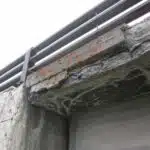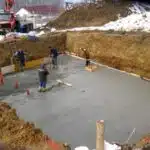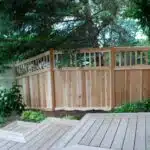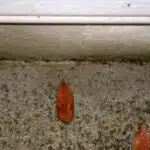Replacing wood fence posts is an essential task for maintaining the structural integrity of a fence. With age, wooden fence posts rot, crack and eventually collapse, compromising the stability of your fence. The process of replacing a damaged or rotted fence post can be daunting and time-consuming, but with proper planning and execution, it can be an easy task.
As a fence installation expert with years of experience in the industry, I have witnessed firsthand the impact of poorly maintained fences on homeowners’ security and privacy. Therefore, I understand the importance of regular maintenance and repair to ensure that your fence remains robust and functional for years to come. In this article, I will provide practical tips on how to replace wooden fence posts effectively. Whether you are a DIY enthusiast or seeking professional help, this guide will equip you with the necessary knowledge to tackle this task successfully.
Identifying The Need For Post Replacement
According to a recent survey, around 80% of fence repairs involve replacing fence posts. This is because fence posts are the foundation of any fence and they bear the weight of the entire structure. Over time, wood fence posts can deteriorate due to exposure to moisture and other weather elements. If not addressed in a timely manner, this can lead to serious safety hazards such as the fence collapsing. Therefore, it is crucial to assess your fence regularly for signs of rot or damage.
Assessing damage is the first step in determining whether your wood fence posts need replacement. One sign of damage is if the post feels loose or wobbly. This could indicate that it has rotted at its base or become unsecured from the ground due to frost heave or soil erosion. Another sign is if you notice cracks or splits on the post’s surface. These could be caused by extreme changes in temperature or moisture levels that have weakened the wood fibers over time.
Signs of rot are another indication that your wood fence posts need replacement. Rot can occur in any part of the post but is most common at the base where it comes into contact with soil and moisture. Look for soft, spongy spots on the post’s surface, which indicate that bacteria and fungi have eaten away at the wood fibers. If you notice any of these signs during your assessment, it’s time to replace your wood fence posts before further damage occurs.
After assessing your fence for signs of damage and rot, it’s time to prepare the necessary tools and materials for replacing your wood fence posts.
Preparing The Necessary Tools And Materials
Choosing quality materials is crucial when replacing wood fence posts. You want to ensure that the new post will be strong enough to hold up the weight of the fence panels and withstand weather conditions. Look for posts made of pressure-treated wood, which has been treated with chemicals to resist rotting and decay. Cedar and redwood are also good options as they naturally resist rotting.
Safety precautions should always be taken when working on a fence project. Make sure you have all the necessary safety equipment, such as gloves, safety glasses, and a dust mask. Before digging, call your local utility company to mark any underground pipes or wires so that you don’t damage them accidentally. Additionally, make sure your work area is clear of any debris or obstacles that may cause tripping hazards.
When preparing for a fence post replacement project, it’s essential to gather all necessary tools and materials beforehand. In addition to the new post, you’ll need a shovel or post hole digger, concrete mix, level, measuring tape, and a hammer or mallet. Having these tools readily available will save time and prevent frustration during the installation process. With proper preparation and attention to detail throughout the entire process, replacing wood fence posts can be done successfully in no time at all.
Transition: Now that you’ve gathered all necessary tools and materials needed for this project let’s move on to removing the damaged post.
Removing The Damaged Post
- Prior to replacing a wood fence post, a thorough assessment of the damage should be done.
- The area around the post should be cleared of all debris, and the ground should be leveled.
- The post should be dug out, taking care to ensure the hole is of adequate size and depth.
- The existing post should be inspected to determine if any of the surrounding soil must be replaced.
- If necessary, the soil should be replaced with a material that is suitable for supporting a fence post.
- The new post should be securely anchored in the hole, and the surrounding soil should be leveled and tamped down.
Assessing The Damage
Wood fence posts can sustain damage due to various factors, such as weather conditions, insect infestations, and accidents. As a fence installation expert, it is essential to assess the extent of the damage before proceeding with removing the post. Assessing the damage involves determining whether the post can be repaired or if it needs replacement.
Repairing a damaged wood fence post may seem like an affordable alternative to replacement. However, it is crucial to note that repairs may not always be effective in restoring the post’s structural integrity. In cases where the damage is severe or widespread, replacing the post may be necessary to ensure that your fence remains sturdy and secure.
Common causes of wood fence post damage include rotting caused by moisture exposure, termite infestation, physical impact from lawn equipment or vehicles, and aging. These factors can weaken the post over time and compromise its ability to support your fence adequately. By assessing the damage and identifying its cause, you can take appropriate measures to repair or replace your wood fence post effectively.
In summary, assessing the damage is a critical step in removing a damaged wood fence post. Before deciding whether to repair or replace the post, it is essential to determine the extent of the damage and identify its cause. By doing so, you can make informed decisions that will ensure your fence’s longevity and keep your property safe and secure.
Preparing The Post Area
After determining whether a damaged wood fence post needs repair or replacement, the next step is preparing the post area for removal. This process involves gathering the necessary tools and taking appropriate safety precautions to ensure that the task is completed efficiently and safely.
The tools needed for removing a damaged wood fence post include a shovel, post hole digger, pry bar, sledgehammer, saw, and gloves. The shovel and post hole digger are used to remove the soil around the base of the post to expose it fully. The pry bar is then used to loosen any concrete or other material that may be anchoring the post in place. A sledgehammer can also be used to break up any stubborn concrete or other materials. Finally, a saw can be used to cut through any remaining parts of the post if necessary.
Before beginning the removal process, it is essential to take safety precautions to avoid injury. This includes wearing gloves to protect your hands from splinters and using proper lifting techniques when handling heavy equipment. It may also be helpful to have someone assist you during the removal process to ensure that you do not injure yourself or cause damage to surrounding structures.
In conclusion, preparing the post area for removing a damaged wood fence post involves gathering necessary tools and taking appropriate safety precautions. By doing so, you can remove the post efficiently and safely without causing harm or damage to yourself or your property.
Digging Out The Post
After preparing the post area, the next step in removing a damaged wood fence post is digging it out. This process involves using tools to break up and remove the soil around the post until it can be lifted out of the ground. Digging out a post can be a challenging task, but with the right tools and techniques, it can be done efficiently.
One common mistake when digging out a post is not removing enough soil from around the base of the post. It is essential to dig deep enough to expose any concrete or other materials that may be anchoring the post in place. Using a shovel and a post hole digger can make this task easier. These tools allow you to remove soil quickly and efficiently, making it easier to access the base of the post.
Another tool that can make digging out a post easier is a pry bar. A pry bar can be used to loosen any concrete or other material that may be holding the post in place. It is also helpful for breaking up stubborn soil around the base of the post. When using a pry bar, it is essential to use caution and avoid damaging surrounding structures or plants. By taking these tips into consideration and using proper tools, you can successfully remove a damaged wood fence post without causing harm or damage to yourself or your property.
Assessing The Surrounding Fence Panels
Like a surgeon assessing a patient’s vital signs, it is crucial to check the stability of the surrounding fence panels before proceeding with the replacement of a wood fence post. This step ensures that the new post will be well-supported and prevent future damage to adjacent panels. Start by examining each panel for any signs of weakness or damage, such as cracks, splits, or warping.
Once you have identified any weak panels in the fence, it is essential to reinforce them before installing the new post. This can include adding additional support beams or braces to strengthen the existing structure. Reinforcing weak panels helps distribute weight evenly across the entire fence line and prevents further damage caused by wind, storm, or other external factors.
By checking stability and reinforcing weak panels before installing a new fence post, you can ensure that your replacement project will last for years to come. In the next section, we’ll discuss how to clean out the old post hole and prepare it for installation of a new post without causing further damage to your fence line.
Cleaning The Post Hole
Clearing debris from the post hole is an essential step in replacing wood fence posts. This process ensures that the new post will be firmly anchored and will not shift or move over time. To begin, remove any remaining wood fragments, rocks, or other debris from the hole using a shovel or hand trowel. Be sure to clear out the entire depth of the hole before moving on to the next step.
After removing all debris, take a moment to inspect the hole for any signs of damage or wear. Look for cracks or holes in the surrounding soil that could indicate future problems with your fence’s stability. If you notice any issues, consider reinforcing the area with additional gravel or concrete before installing your new post.
Preventing future damage is another crucial aspect of cleaning out your post hole. Before placing your new post into position, line the bottom of the hole with at least two inches of gravel. The gravel will help promote drainage and prevent water from collecting around your fence’s base, which can lead to rot and decay over time. With these precautions in place, you can rest assured that your new post will last for many years to come.
- Begin by removing all debris from within and around the post hole.
- Inspect the surrounding soil for any signs of damage or wear.
- Consider reinforcing the area with additional gravel or concrete if necessary.
- Line the bottom of the hole with at least two inches of gravel to promote drainage and prevent future damage.
Moving on to measuring and cutting your new post…
Measuring And Cutting The New Post
After cleaning out the post hole, it is time to measure and cut the new post. One of the most important things to consider when replacing fence posts is measuring accuracy. The new post must be cut to the exact height of the old one, so that the fence remains level.
To accurately measure the height of the old post, use a tape measure or ruler. Measure from ground level up to where the old post meets the horizontal rails of the fence. Next, using your cutting techniques, saw off any damaged or rotten part of the old post. Then, transfer this measurement to your new post and mark it with a pencil.
When cutting your new post, ensure you are using proper techniques for safety and accuracy. Use a saw that is appropriate for your type of fence posts and make sure it is sharp before starting. Cut slowly and steadily, keeping your blade perpendicular to the post as you go through it. Be sure to double-check your measurements before making any cuts.
Next section: Preparing the New Post for Installation
With your new post cut to size, it’s time to prepare it for installation.
Preparing The New Post For Installation
- When preparing to install a new wood fence post, one of the first steps is to dig a hole that is deep enough to provide the post with a secure footing.
- The hole should be at least 12 inches in diameter, and should be slightly wider at the bottom than the top.
- After the hole is dug, the post should be set in concrete to provide additional stability.
- The post should be set at the desired height, approximately 3 inches higher than the surrounding grade, and should be level and plumb.
- The concrete should be mixed according to the manufacturer’s instructions and poured into the hole around the post.
- Once the concrete has been poured, it should be leveled, tamped and allowed to cure before the fence is attached to the post.
Digging The Hole
When it comes to replacing wood fence posts, digging the hole is a crucial step that must be done properly. Common mistakes include not digging deep enough or wide enough, resulting in a post that is unstable and prone to leaning. To avoid these issues, it’s important to use proper equipment and take your time with the digging process.
One of the most important pieces of equipment when digging a hole for a new fence post is a post hole digger. This tool allows you to easily remove soil from the ground without damaging any underground utilities or structures. Additionally, you’ll want to make sure you have a shovel or other digging tool on hand in case you encounter any rocks or roots. By using the right tools, you can ensure that your new fence post will be securely anchored in the ground.
Another key factor when digging the hole for a new fence post is making sure it’s large enough to accommodate the size of the post. A good rule of thumb is to dig a hole that’s at least three times wider than the diameter of your fence post and at least one-third deeper than its length. This will give your new post plenty of room to settle into the ground and provide stability for your fence overall.
In conclusion, taking care when digging the hole for your new fence post can make all the difference in ensuring a sturdy and long-lasting fence. Avoid common mistakes by using proper equipment and taking your time with the process, and remember to make sure your hole is big enough to accommodate your new post before installing it into place.
Cementing The Post
Once you have dug the hole for your new fence post, it’s time to prepare it for installation. One crucial step in this process is cementing the post into place. Mixing cement and using it to anchor the post can provide added stability and security for your fence. However, there are also alternative options for cementing that may be more suitable depending on your specific needs.
When using cement to secure your fence post, it’s important to mix it properly according to the manufacturer’s instructions. This will ensure that the cement sets correctly and provides the necessary support for your fence. You’ll want to make sure you have enough cement mixture on hand before beginning the installation process, as running out halfway through can cause delays and potentially compromise the integrity of your fence.
If you prefer not to use cement when installing your new fence post, there are other options available. For example, you could use a gravel or crushed stone base instead of pouring concrete. Additionally, there are specialized brackets and anchors available that can provide added support without requiring any concrete at all. By exploring all of these options and choosing the one that best fits your needs, you can ensure a successful installation process and a sturdy, reliable fence for years to come.
Leveling The Post
Before installing a new fence post, it’s important to properly prepare the site and ensure that the post is level. Checking stability and adjusting height are crucial steps in this process. A stable fence post will prevent your fence from leaning or falling over, while a level post will provide an even foundation for your fence panels.
To check the stability of your new fence post, give it a gentle push in all directions. If it wobbles or feels unstable, you may need to dig the hole deeper or add more cement mixture to secure it into place. Once the post is stable, use a level tool to determine if it is straight up and down. Adjusting the height of your post may also be necessary if you want to align it with existing fences or structures.
To adjust the height of your new fence post, carefully add or remove soil from the bottom of the hole until it sits at your desired height. Use a level tool throughout this process to ensure that the post remains straight and even. Once you’ve achieved both stability and levelness, you can proceed with securing the post into place using cement or another suitable method. With careful preparation and attention to detail, you can ensure that your new fence post provides a sturdy foundation for your entire fencing system.
Inserting The New Post Into The Hole
The next step in replacing a wood fence post is to insert the new post into the hole. Before doing so, it is important to ensure that the hole is deep enough for the new post. The proper depth for a fence post hole should be at least one-third of the length of the post itself, plus an additional six inches. This will provide adequate stability and prevent the post from leaning or shifting over time.
Once you have determined that the hole is deep enough, it is time to set the post straight. This can be done by using a level and adjusting as necessary until it is perfectly vertical. It may also be helpful to have someone hold the post in place while you fill in the hole with concrete or other stabilizing material. Remember to tamp down each layer of material as you go to ensure maximum stability.
When inserting a new fence post, proper depth and alignment are key factors in ensuring its longevity and stability. By taking care to set your post straight and at the correct depth, you can help avoid future problems and keep your fence looking great for years to come. In our next section, we will discuss how to align and secure your new fence post once it has been inserted into place.
Aligning And Securing The Post
Accurately measuring the post is essential to ensure the post is the correct size and length. A hole should be dug to the recommended depth, which is dependent on the type of post being installed. Once the post is in the hole, it should be checked to ensure it is completely vertical and secure. To provide further stability, concrete should be added around the post, ensuring it is level with the ground. The concrete should be allowed to cure for a minimum of 24 hours before any further work is done. Finally, the post should be securely fastened to the fence frame.
Measuring The Post
Ensuring the accuracy of measurements is vital when replacing wood fence posts. Measuring the post is an essential step in aligning and securing the post to ensure that it fits perfectly into the ground. As a fence installation expert, I recommend using measuring tools such as a tape measure, level, and square to ensure that your measurements are precise.
When measuring the post’s length, make sure to account for any additional height you may need above ground level. It is advisable to extend the post at least three feet above ground level to provide sufficient support for the fence. Additionally, measure the width of the post so that it fits snugly into its designated hole. Accurate measurements will ensure that your new fence post will be stable and secure.
Measuring accuracy is crucial in fence installation as even minor miscalculations can lead to significant problems down the line. Using proper measuring tools and techniques can help you avoid costly mistakes and save you time in the long run. Remember, taking accurate measurements is key to ensuring a successful fence installation project.
Digging The Hole
To ensure that your fence post is stable and secure, aligning and securing the post are crucial steps in fence installation. After taking accurate measurements of the post’s length and width, the next step is to dig the hole. Proper equipment and safety precautions must be taken when digging the hole to avoid any accidents or damage to property.
The first step in digging the hole is to mark the area where you want to install the fence post. Once you have marked the location, use a post-hole digger or an auger to start digging. Make sure that you dig a hole that is deep enough for your fence post, accounting for any additional height needed above ground level.
When digging the hole, it is crucial to take safety precautions such as wearing protective gear like gloves and safety glasses. Also, make sure that there are no underground utilities such as gas lines or electrical cables in the area where you will be digging. Hitting an underground utility can cause significant damage and even lead to loss of life.
In conclusion, aligning and securing your fence post requires precise measurements and proper techniques. Digging a hole may seem like a straightforward task but should not be taken lightly. Always prioritize safety when working on your fence installation project by using proper equipment and taking necessary precautions.
Securing With Concrete
Ensuring that your fence post is secure and stable is crucial in fence installation. In addition to aligning the post, it is essential to secure it with concrete. The importance of depth cannot be stressed enough when securing a post with concrete. A hole that is too shallow will not provide adequate support for the fence, while a hole that is too deep can result in unnecessary waste of concrete.
When mixing concrete, it is important to follow the manufacturer’s instructions carefully. This involves using the correct ratio of water to cement and ensuring that the mixture is thoroughly combined. If you’re unsure about how to mix concrete properly, it’s best to seek advice from an expert or refer to instructional materials.
Once you have mixed your concrete, pour it into the hole around the fence post until it reaches ground level. Make sure that the post is level before allowing the concrete to dry completely. Securing your fence post with concrete not only adds stability but also ensures that your fence stands strong against harsh weather conditions and external forces.
Backfilling The Hole With Concrete
As the saying goes, “A job worth doing is worth doing well.” When it comes to replacing fence posts, one of the most critical steps is backfilling the hole with concrete. This ensures that the post remains firmly in place and can withstand any stress or strain that may be placed upon it.
Mixing concrete may seem like a straightforward task, but it’s essential to get the correct ratio of cement, sand, and water. The mixture should be thick enough so that it doesn’t run down into the hole but not too dry that it won’t fill all of the gaps around the post. Using a wheelbarrow or mixing tray can help ensure a consistent mix every time.
If you’re looking for an alternative to using concrete as backfill for your fence post, there are several options available. Some people use gravel or rocks instead of concrete, while others choose to use foam backfill products designed specifically for this purpose. However, keep in mind that these alternatives may not provide the same level of stability as concrete and may need more frequent maintenance over time.
Once you’ve mixed your concrete and filled in around the post, allow it to cure for at least 24 hours before continuing with any further installation steps. This will ensure that the post is entirely secure and ready to support your fence panels without any risk of wobbling or instability. In our next section, we’ll discuss how to properly allow the concrete to cure so that your fence installation can proceed smoothly and efficiently.
Allowing The Concrete To Cure
After the concrete has been poured into the hole and around the post, it is important to allow it to cure properly. This means waiting a certain amount of time before continuing with the installation process. Waiting for the concrete to cure will ensure that the fence post is firmly secured and prevent damage from occurring later on.
The length of time needed for curing can vary depending on factors such as weather conditions and humidity levels. Typically, you should wait at least 24 hours before moving onto the next step in the installation process. However, some experts recommend waiting up to three days to allow for maximum strength and stability.
In addition to waiting for the concrete to cure, it’s also important to take steps to prevent damage during this time. Avoid leaning anything against the fence post or putting any weight on it until it has fully cured. This will help ensure that the post remains secure and that your fence remains stable over time.
Now that you have allowed ample time for curing, it’s time to move onto reattaching the fence panels. But before doing so, make sure to double-check that your posts are fully cured by giving them a gentle tap with a hammer or other hard object. If they feel firm and secure, then you’re ready to move onto the next step in your wood fence replacement project.
Reattaching The Fence Panels
After allowing the concrete to cure for a sufficient amount of time, it’s time to start reattaching the fence panels. This involves securing the panels onto the newly installed posts, ensuring they are straight and level. To do this, you’ll need screws or nails and a hammer or drill.
Firstly, begin by positioning the panel against the new post and use a level to make sure it’s straight. Once you’re satisfied with its position, insert your screws or nails into the panel at an angle towards the post. This will help prevent future damage caused by wind or other external factors that could loosen the panel over time.
To further ensure that your fence is secure and protected from potential damage in the future, consider implementing some additional measures. Start by adding a layer of sealant or paint to protect both your fence and your wood posts from weathering and rotting. Additionally, consider installing metal brackets around each post for added stability and protection against harsh weather conditions.
By taking these extra steps to secure your fence panels and prevent future damage, you can rest assured that your investment is protected for years to come. Now that you’ve completed these important steps in replacing your wood fence posts, it’s time to move on to applying finishing touches that will give your fence a polished look.
Applying Finishing Touches
- Sealing the post is essential to prevent water from seeping in, which could cause the post to rot or weaken over time.
- For a longer lasting finish, adding a layer of paint or stain to the post is recommended for aesthetic purposes as well as for protection.
- Capping the post with a post cap is a simple way to add a finished look to the fence.
- A sealant should be applied to seal the post cap in place and to protect the wood from moisture.
- Capping the post with a metal post cap is recommended for added protection against the elements.
- A sealant should also be applied to the edges of the post cap to ensure a tight seal and to prevent water from entering the post.
Sealing The Post
Sealing the Post is an essential step in replacing a wood fence post. The sealing process helps to protect the post from weather conditions that can cause rot and decay. There are various sealing methods available, including applying a coat of sealant or paint to the post’s surface.
One of the most effective sealing methods is using weather-resistant sealant. This type of sealant is specially formulated to prevent water penetration, which can lead to rot and decay. It also provides protection against UV rays that can make wood brittle and prone to cracking. Applying weather-resistant sealant ensures that your fence post will last longer and require less maintenance over time.
In addition to using weather-resistant sealant, it’s also important to ensure that you apply the finishing touch before installing the post back into the ground. This will help prevent moisture from penetrating the bottom of the post and causing rot from below. By following these steps, you can be sure that your newly replaced fence posts will be protected against harsh weather conditions for many years to come.
Adding Paint Or Stain
Now that the fence post has been sealed, it’s time to add the finishing touch by painting or staining the post. Adding a coat of paint or stain not only enhances the overall look of the fence but also provides an extra layer of protection against harsh weather conditions. However, it’s important to choose the right type of paint or stain to ensure long-lasting results.
When choosing paint or stain, consider factors such as the type of wood and climate in your area. For example, if you live in an area with high humidity levels, a water-resistant stain would be a better option than regular paint. It’s also important to choose a color that complements your home’s exterior while still providing enough contrast to make the fence stand out.
One common mistake to avoid when painting or staining a fence is applying too much product at once. This can result in drips and uneven coverage. Instead, apply thin coats and allow each coat to dry completely before applying another one. By taking these tips into consideration, you can ensure that your newly replaced fence post not only functions well but also looks great for years to come.
Capping The Post
After sealing and painting the fence post, the final step in finishing your fence project involves selecting a suitable cap for the post. A fence post cap serves as a protective layer for your post, preventing water damage and extending its lifespan. With various fence post capping options available in the market, it’s crucial to understand the pros and cons of each type to make an informed decision.
One popular option is the flat-top cap that sits flush with the top of the post. This type of cap provides a clean and modern look but may not be ideal for areas with heavy rainfall as it can accumulate water on top. Another option is a ball-shaped cap that adds a decorative touch while still providing protection against moisture damage. However, this type of cap requires more maintenance as it tends to attract dirt and debris.
For those looking for a more natural look, a wooden pyramid-shaped cap may be the perfect choice. This type of cap complements wooden fences well and is easy to install. However, it may require frequent replacement due to weathering over time. Lastly, there are also solar-powered caps that light up at night, providing added security and visibility around your fence perimeter.
In summary, choosing the right fence post cap depends on your personal preferences and needs. Consider factors such as functionality, style, durability, and maintenance requirements before making your decision. With various options available in the market today, you’re sure to find one that suits your needs while adding an extra touch of beauty to your newly installed fence!
Regular Maintenance Tips
Regular Maintenance Tips:
Maintaining your fence is essential to ensure it remains in optimal condition and lasts for years to come. Preventative measures are key, and there are certain things you can do to keep your fence posts in good shape. One of the most common causes of post damage is moisture. When soil around the post becomes saturated with water, it can cause the wood to rot or break down over time.
Another important factor to consider is temperature changes. Exposure to extreme heat or cold can also cause wooden fence posts to expand or contract, leading to cracks or breaks. To avoid these problems, it’s critical to regularly inspect your fence for any signs of damage and address them promptly.
Regular maintenance tasks include cleaning your fence regularly with a power washer or hose and removing any debris that may have accumulated around the posts. You should also repaint or stain your fence every few years to protect against weather conditions that could lead to rotting or cracking.
| Maintenance Task | Frequency | Time Required |
|---|---|---|
| Cleaning | Every 6 months | 1-2 hours |
| Repainting/Staining | Every 2-3 years | 4-8 hours |
By following these simple steps, you can keep your wooden fence posts in good condition and prevent costly repairs down the road. Remember that prevention is always better than cure when it comes to maintaining your property.
When it comes time for more extensive repairs, such as replacing entire sections of fencing or dealing with severe rotting, it may be best to call in a professional installer. A professional will have the necessary tools and expertise needed to complete the job safely and efficiently, ensuring that your fence remains strong and beautiful for years to come.
When To Call A Professional
Regular maintenance is crucial in ensuring that your wood fence stays in good condition for years to come. However, even with the best care, there comes a time when your fence posts need to be replaced. This can be due to several reasons such as age, weathering, and damage caused by pests or accidents.
When it comes to replacing fence posts, it’s important to know when you can handle the job yourself and when it’s time to call a professional. Signs of irreparable damage include rotting or splitting of the post, severe leaning, and cracks in the concrete footing. Attempting to replace a post with these issues can result in further damage and compromise the stability of your entire fence.
If you notice any of these signs or are unsure about your ability to replace a post properly, it’s best to call a professional. A fencing contractor will have the necessary tools and expertise needed to complete the job safely and efficiently. They can also assess the overall health of your fence and recommend any additional repairs or replacements that may be necessary.
- Before calling a professional, make sure you have an idea of what type of wood and style of fencing you currently have.
- Clear any debris around the damaged post area.
- Make sure there is enough space for equipment and materials needed for repair.
- Consider getting multiple quotes from different contractors before making a final decision.
Remember that maintaining your wood fence is an investment in both its longevity and aesthetic appeal. Knowing when to call a professional for repairs can save you time, money, and potential safety hazards associated with DIY repairs. Don’t hesitate to seek expert help if you’re unsure about handling this task on your own.
Conclusion
Replacing wood fence posts may seem like a daunting task, but with the right tools and know-how, it can be done easily. Identifying the need for post replacement is crucial in ensuring that your fence remains sturdy and secure. Preparing the necessary tools and materials before starting the project saves time and effort.
Removing the damaged post requires careful attention to detail as it involves dismantling sections of the fence. Assessing the surrounding fence panels is important to ensure that they are not damaged in the process. Cleaning the post hole is essential to prevent rot or decay from affecting your new post’s integrity. Reattaching the fence panels and applying finishing touches completes this DIY project.
Regular maintenance tips such as cleaning, staining, or painting your fence can extend its life span, saving you money in the long run. However, when faced with complex issues like rotted posts or extensive damage, calling a professional is always recommended.
As a fence installation expert, I advise homeowners to stay vigilant about their fence’s condition and take immediate action when repairs are needed. With these simple steps, you can replace your wood fence posts like a pro while ensuring that your property remains secure and aesthetically pleasing for years to come. So why wait? Get started on your next DIY fencing project today!
Image Credits
- “160521-wood-fence-post-field.jpg” by r.nial.bradshaw (featured)





























